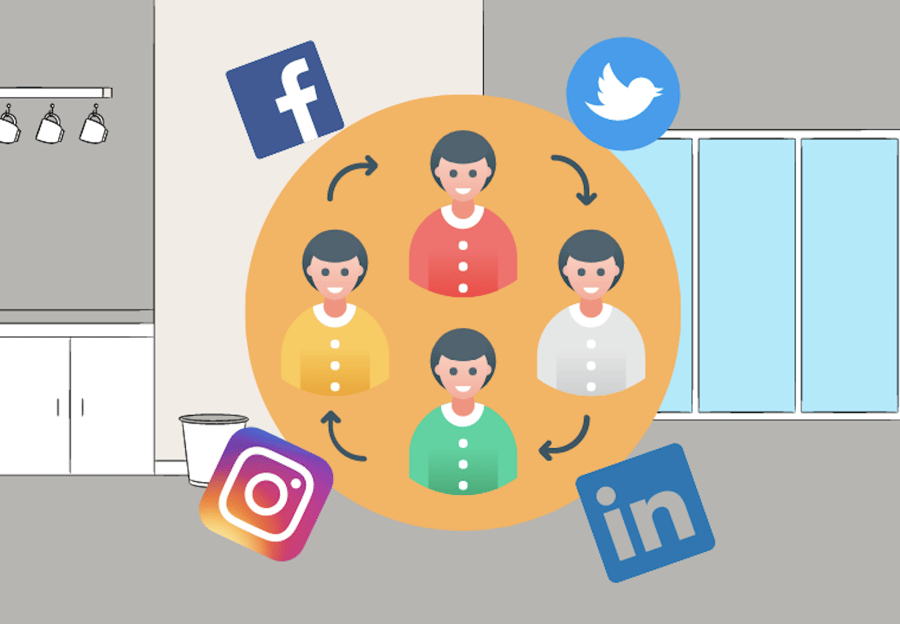
Written By:
Yor Madrio
Social media has become an essential part of our daily lives and transformed the way higher education institutions interact with students, faculty, and the general public. It has provided a platform for schools to share their stories, connect with their current and prospective students, and promote their mission statements and values.
However, building a strong social media team for higher education requires more than just posting content on Instagram or TikTok. It takes careful planning and strategizing to ensure your institution's message resonates with your audience.
If you’re hoping to build a strong higher education social media team, here’s an overview of what that team might look like, what kinds of roles you should consider hiring, and the steps you should take to make your team successful.
What Is a Social Media Team?
A social media team is a group that focuses on growing the business by strategically creating content, ads, and engaging with the target audience on different social media platforms. In higher education, its main role is to increase enrollment by creating content and advertisements on popular social media channels that current and prospective students use.
This team is also responsible for every aspect of social media management, including paid media, data analysis, community outreach, and more. The growing demand for this kind of marketing and communication strategy at institutions has led to many personnel changes but has also led to some growing pains.
The only way to combat these issues is to address the various roles that social media teams need to succeed. If you’re hoping to build up your team, here’s a closer look at the different roles a social media team should have.
Who Is on a Social Media Team?
Core Roles
Filling core roles on your social media team is crucial to the long-term success of your institution's social media strategy. These roles work together to develop, implement, measure, and manage the institution's social media channels effectively. They also enable the institution to produce high-quality content that engages its audience and aligns with the institution's values and mission.
In general, a social media team in higher education should consist of individuals with diverse skills in content creation, graphic design, analytics, and community management. Some of these essential social media roles include:
Social Media Manager
Average years of experience: 2–3
Average salary: $51,554
Job description: Develops social media strategies, executes campaigns, and analyzes engagement data
Content Creator
Average years of experience: 1–3
Average salary: $48,589
Job description: Creates content for a college’s social media channels
Paid Media Manager
Average years of experience: 2–3
Average salary: $63,376
Job description: Manages a college’s paid social media campaigns, including ad creation, placement, and analysis
Analyst
Average years of experience: 1–3
Average salary: $54,777
Job description: Tracks and analyzes a college’s social media performance, creates reports, and makes recommendations for improvement
Community Manager
Average years of experience: 1–3
Average salary: $65,510
Job description: Engages with a college’s social media followers, responds to comments and messages, and builds relationships with the community
Without these roles, your institution is more likely to struggle to maintain a consistent and engaging social media presence, which can result in a lower engagement rate and overall enrollment numbers.
Auxiliary Roles
After filling the core roles of a social media team, you should consider hiring auxiliary roles to ensure your team can effectively meet its objectives. While these roles aren’t essential to your team’s success, they often provide support for the core team members in creating more compelling content.
Some examples of auxiliary roles on a social media team include
Photographer
Average years of experience: 1–3
Average salary: $43,905
Job description: Takes photos and edits visual content for a college’s social media channels
Videographer
Average years of experience: 1–3
Average salary: $50,989
Job description: Shoots and edits videos for a college’s social media channels
PR Specialist
Average years of experience: 2–4
Average salary: $69,899
Job description: Manages a college’s public relations efforts on social media, including crisis management and media relations
Having auxiliary team members can provide more space for the core team members, allowing them to focus on their primary responsibilities and ultimately lead to better outcomes.
Getting the right team members, however, is only one part of the equation. Here are four additional steps you should take when setting your social media team up for success.
4 Steps in Building Your Social Media Team
1. Set Your Goals
Setting goals is a critical step in developing a social media team for higher education. Without clear goals, creating a strategic plan that aligns with the institution's mission and values can be challenging.
Higher education institutions can identify areas where they need to improve and develop strategies, such as:
- Increasing engagement can help an institution focus on creating content that encourages dialogue and feedback
- Increasing brand awareness can help an institution create a social media strategy that showcases the unique programs and offerings of the institution
Your goals, like the ones above, can provide direction and help you better measure the success of your team’s social media efforts.
2. Determine Your Team’s Size
The size of your team also plays a key role when building up your social media department. Teams that are too small may not have the capacity to manage all the necessary tasks (e.g., content creation, engagement, and analytics), but those that are too large can lead to more inefficiencies.
The appropriate team size largely depends on:
- Your team’s goals
- The number of social media channels being handled
Advocating for a team expansion to your stakeholders could be a challenge, but when raising concerns such as goals not being met, or extra expectations that have been added due to your social media’s growth, the argument can be made that adding an extra person can prove beneficial. One-person social media teams are prone to burnout much faster than teams with more members, and burned-out teams perform worse and produce lesser quality content.
3. Choose a Team Structure
Having a set team structure is necessary for the success of a higher education social media team. It helps to ensure your team is aligned with the institution’s goals and objectives, and that resources are effectively used to achieve desired outcomes. Additionally, having a clear team structure can help better establish roles and responsibilities, improve communication, and enhance productivity.
Here are some examples of team structures commonly used for higher education social media teams:
- Organic: A “free-for-all” structure that encourages creativity and experimentation, but can also lead to disorganized content and messaging that makes it difficult to achieve specific goals.
- Centralized: A standalone social media team that enables more focus on social content, which can result in more effective planning and execution of campaigns.
- Hub and Spoke: A central team working with other departments to facilitate collaboration, encourage sharing of resources, and ensure consistency in messaging across different channels.
- Holistic: A highly collaborative structure where every employee at the college is involved in social media in some way, fostering a culture of social media advocacy and leading to more diverse and creative content.
4. Ask for Support When Needed
No matter what structure you choose, you still may need additional support during busy times of the year. In those cases, using interns and work-study students can be highly beneficial.
Some of the most common benefits of hiring interns include:
- Gaining fresh perspectives: Interns and work-study students are typically younger and may have different perspectives on social media trends and strategies that could be valuable to your team.
- Saving money: Hiring interns and work-study students can be a cost-effective way to expand the social media team's capacity without incurring significant expenses.
- Developing skills: Interns and work-study students can gain valuable skills and experience through their work on your social media team, which can benefit them in their future careers.
- Increasing productivity: Having additional team members, even if they are temporary, can increase the overall productivity of the team by allowing for more projects to be completed.
- Obtaining potential hires: Interns and work-study students can be a valuable source of potential future hires for the social media team or other departments within the college.
Start Building Your Social Media Team
Despite the various factors that can affect your social media team development, these steps should bring you a few steps closer to forming your dream social media department. From setting goals to team structure, applying these steps to your social media team is now in your hands.
Here’s another tool that could be helpful when posting on social media, our Pre-Publishing Checklist! You can use it to help boost engagement, enhance your messaging, and ensure quality across all of your social media posts.







